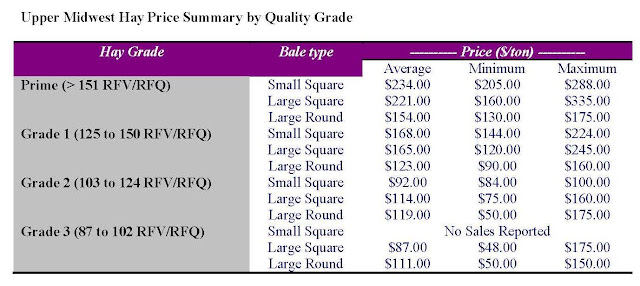Be safe. Hay prices are steady for top quality dairy hay and quality hay is in short supply. Overall the market has some weakness with an increased volume of lower quality hay available. Livestock markets are influencing the hay market. If you need forage or have forage to sell, connect to the Farmer-to-Farmer webpage at http://farmertofarmer.uwex.edu/. You may contact your local county agriculture educator if you need help placing an ad. There is no charge for the service.
Straw prices are for oat, barley, or wheat straw. Straw prices are strong. Small square bales averaged $6.00 a bale (range of $3.50 to $6.00). Large square bale straw averaged $53.00 per bale (a range of $30.00 to $100.00). Large round bale straw averaged $43.00 per bale (a range of $25.00 - $70.00).
In Nebraska, alfalfa hay sold fully steady. Demand picked up a tick with distillers in short supply. Many livestock farmers are eyeing green grass rather than stored feed. In Iowa, top quality hay had a steady price. All other classes of hay were steady to weak.
In South Dakota, very few reported sales and demand is light. Current livestock and dairy markets are influencing the hay market.
In Missouri, hay movement has slowed as many are looking to green grass rather than stored feed. Hay supply is moderate; demand is light, with overall steady prices. Many farmers are busy with spring field work.
In Southwest Minnesota, prices were steady to weak, with a limited supply of quality hay at the market. In Kansas, hay trade is slow, with steady prices. Farmers are busy with fieldwork.
In Wisconsin, prices are steady, but there is a weaker trend beginning. Dairy and livestock markets are lower and have influenced the hay market.
 |
| #completeforageprogram |


No comments:
Post a Comment